Michigan’s Kal-Haven Trail State Park
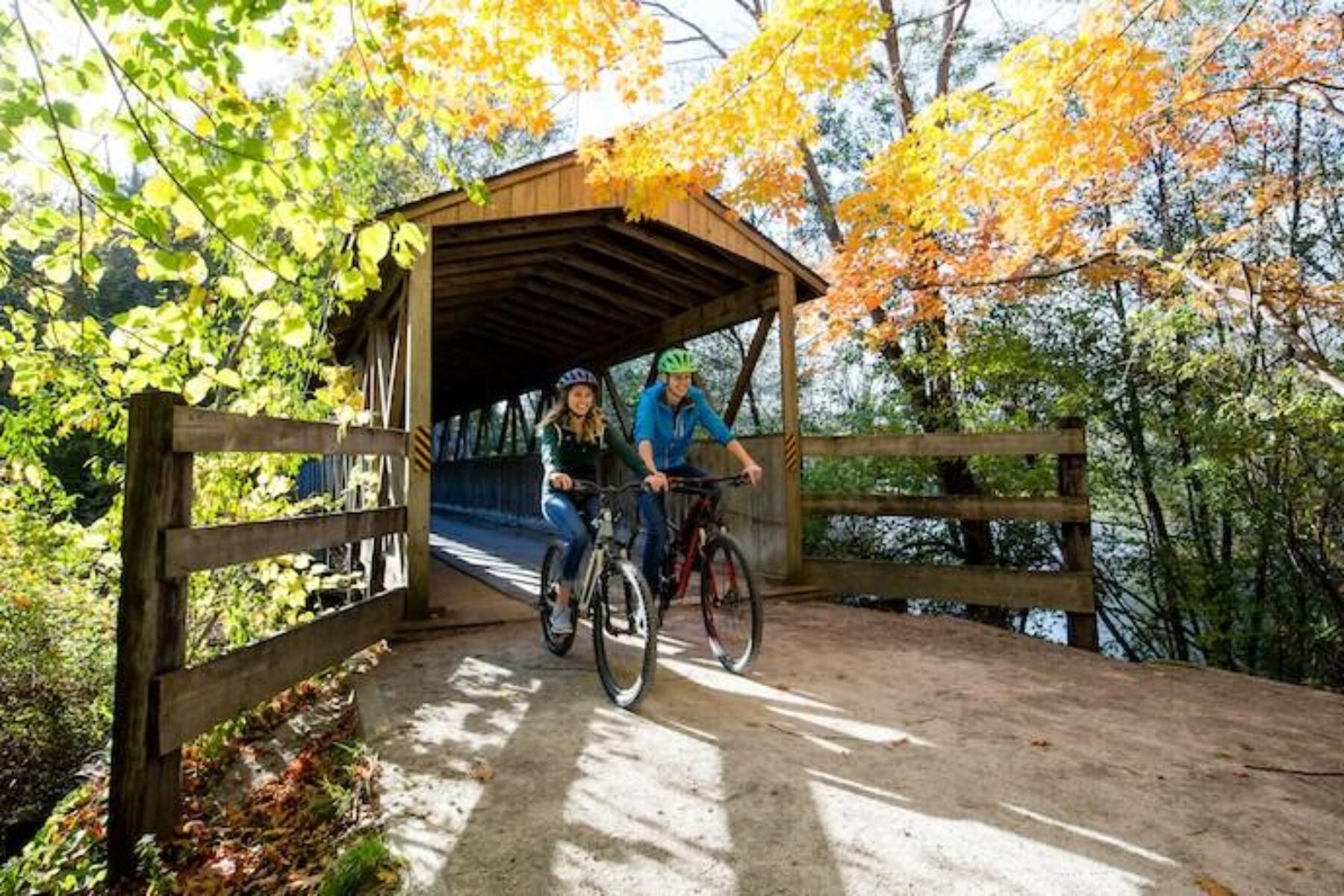
Trail of the Month: December 2022
Leading from South Haven to Kalamazoo, Michigan’s Kal-Haven Trail State Park ranks as one of the state’s most popular rail-trails. Comprised of a nearly unbroken 34-mile tunnel of hardwood trees, the trail is cool and shady in summer and spectacularly colorful in fall, blazing with shades of red and yellow. Wildflowers add pops of color along the trail, beginning in the spring with snowy-white trilliums and purple violets, and followed by profusions of coneflowers, black-eyed Susans and asters as the seasons progress.
“On any summer weekend if you go past the Country Fare Restaurant in Grand Junction [near the Kal-Haven’s midpoint], you’ll see the bike rack outside the door filled with bicycles,” said Jeff Green, chair of the Friends of the Kal-Haven Trail. “[The town of] Alamo had a small trail lot for two to three cars that now holds five or seven cars, because trail users have squeezed in. And intersections all along the trail typically have one or two cars parked alongside the trail.”
Small communities and the remains of once-booming railroad towns appear as the trail wends its way over the contours of rural southwest Michigan. And informational panels enlighten users about what they are seeing and about what has long since faded away.
Retreat Into the Trees
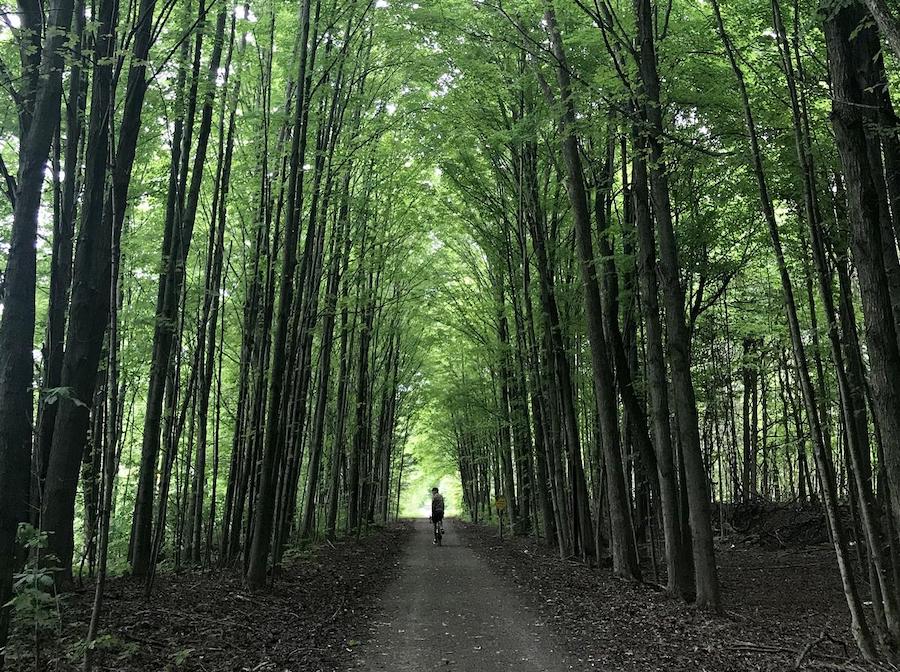
The Kal-Haven Trail traces its modern history to 1973. Two years prior, the Penn Central Railroad had abandoned the Kalamazoo & South Haven rail line. Residents of South Haven and Kalamazoo saw an opportunity to transform the property into recreational land and approached the Michigan Department of Natural Resources (MDNR) about converting the corridor into a multiuse trail.
After a few fits and starts—financing hurdles, an offer from the state of Michigan to fund land acquisition and eleventh-hour protests that the trail might increase crime—the Kal-Haven Trail officially opened to the public in 1989 as Michigan’s first linear state park.
Although there are six official trailheads with parking lots, the Kal-Haven’s rural nature makes it easy to access at numerous points utilizing roadside parking. A charming, covered bridge marks the trailhead in South Haven, and a bright-red restored caboose signals the endpoint in Kalamazoo. Except for brief paved stretches in South Haven, Kalamazoo and Bloomingdale, crushed limestone makes up the trail’s surface. The fine gravel and a nearly flat railbed make this trail suitable even for beginners. Restrooms and water stations serve trail users every few miles.
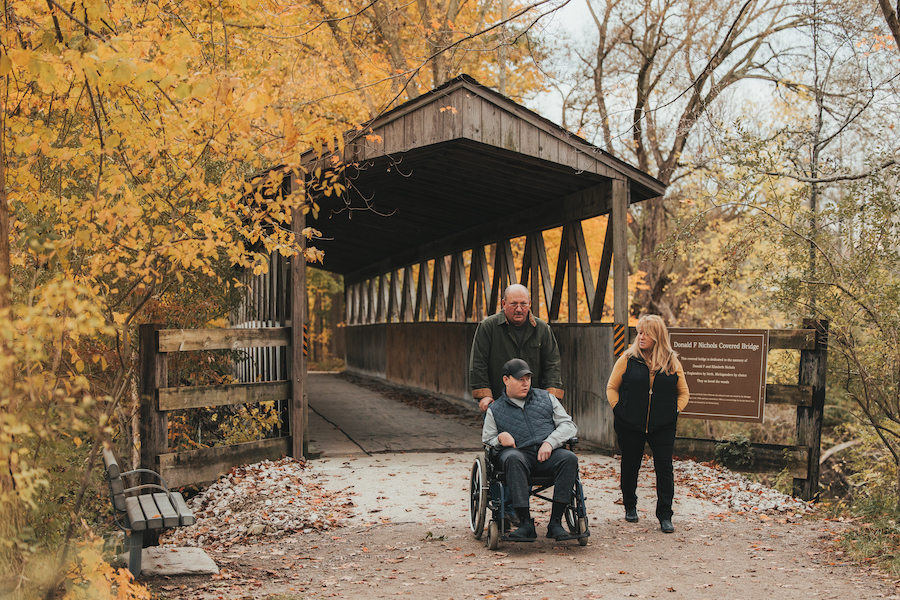
“I think besides the trees, most trail users think the Kal-Haven’s bridges are its real highlights,” said Green. “The covered bridge in South Haven is iconic. And the Camelback [near Grand Junction] is really a beautiful bridge, too.”
In 2022, the state of Michigan committed to investing $5 million for the resurfacing of the Kal-Haven Trail, a project expected to be completed in 2023. But according to Green, trail users need not worry that the trail’s rural aesthetic will be lost. The lion’s share of the money is targeted at reinforcing bridge abutments, most of them built in 1870 for the railroad. The remaining funds will pay for fresh gravel on the trail’s most heavily used portion, between South Haven and Bloomingdale.
“There are no plans to pave the Kal-Haven Trail,” said Green. “The beauty of this trail comes from its natural appearance, and it will stay that way. We want people to feel like when they leave the busyness of Kalamazoo and South Haven, they are in the midst of nature.”
RELATED: Top 10 Trails in Michigan
Michigan’s Heritage in View
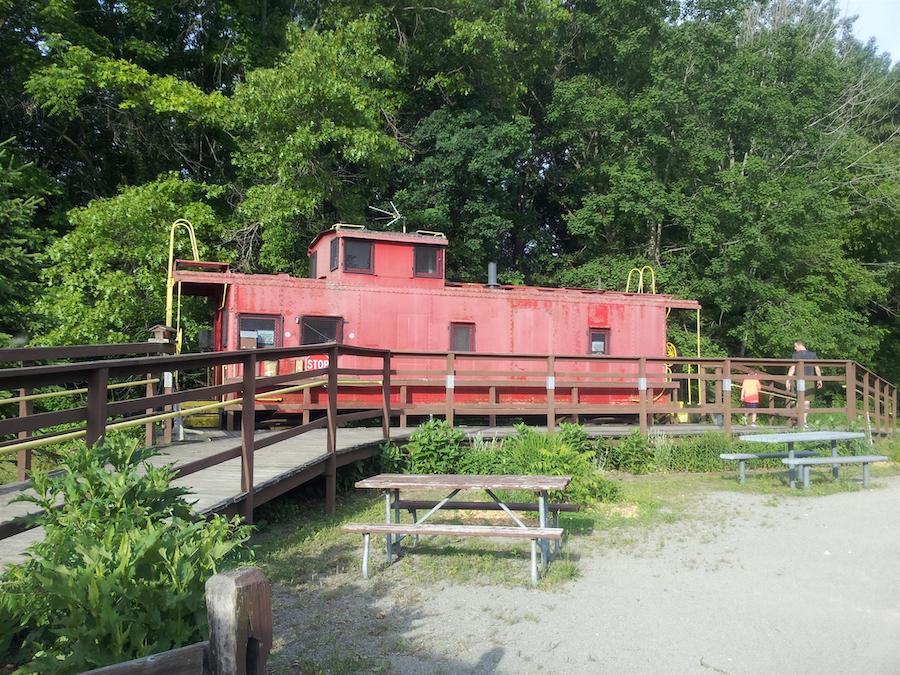
The quiet beauty of the Kal-Haven Trail and its easy terrain might be reason enough to explore this route, the second oldest of Michigan’s 134 rail-trails (the Haywire Grade Trail in the Upper Peninsula is the oldest). But besides offering an immersive natural experience, the Kal-Haven Trail documents southwest Michigan’s history.
“When the Kalamazoo & South Haven Railroad began constructing the rail line in 1869, little towns popped up all along the way, from Kalamazoo to South Haven,” said Green. “People were anxious to take advantage of the new economic opportunities.”
West Michigan’s abundant orchards made the region a key supplier to produce markets in Chicago via a bustling Lake Michigan port in South Haven. The new railroad gave rise to small towns—Kibbie, Lakota, Berlamont, Mentha—where 19th-century fruit growers, sawmills and other manufacturers leapt at the new transportation link to the Windy City.
By the end of World War II, rail traffic began to slow, and in 1971, it ceased entirely. And with the disappearance of the Penn Central Railroad went its small rail towns. Determined not to allow local history to be forgotten, the Friends of the Kal-Haven Trail spent three years researching the stories behind the disappeared communities. In 2015, the Friends partnered with the MDNR to produce and post 31 explanatory history panels that include text, maps and archival photos.
One of the trail’s panels tells of the abandoned town of Berlamont, once home to the YMCA’s Camp Kilbourne and a training ground for Joe Louis. The world heavyweight boxing champion from Detroit engaged here in “rest and roadwork”—and resistance training with a crosscut saw—before his 1948 title match with Jersey Joe Walcott.
Another panel recalls the long-lost town of Mentha, once the location of a 2,000-acre mint farm that produced fully 98% of the nation’s mint oil. A bed of fresh peppermint brings to life the local crop that became a nationwide sensation a century ago thanks to the introduction of mint toothpaste and chewing gum.
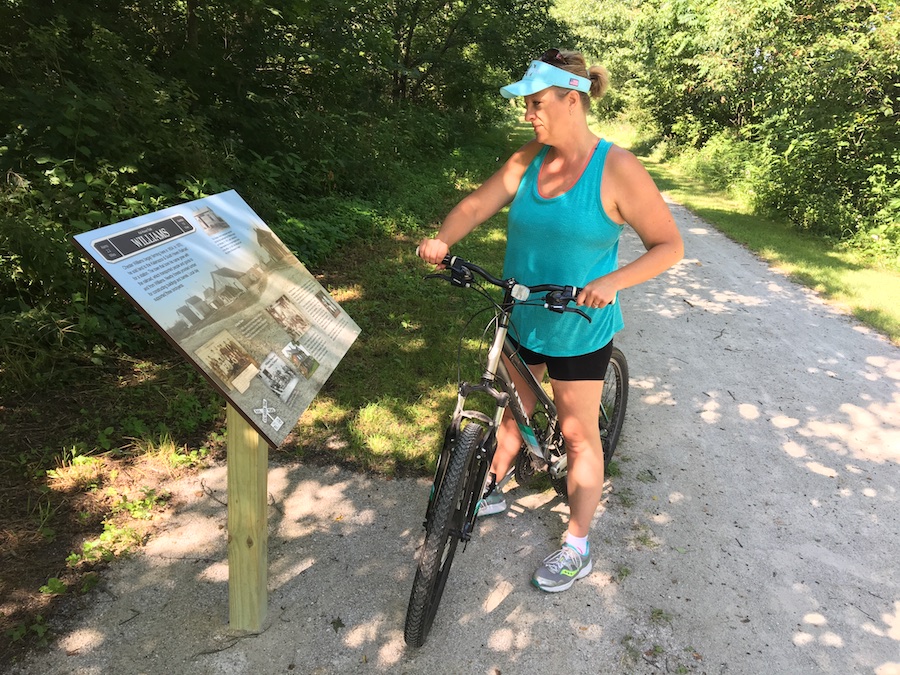
“Our goal was to enhance the trail’s connection to the people and the places of the past,” said Dan Spegel, who was involved in the Kal-Haven history project and is now the Heritage Trail coordinator for the MDNR’s Michigan History Center. “We wanted to provide context, to add texture, to these places.”
From Spegel’s perspective, telling histories like those surrounding the Kal-Haven adds depth to the modern user’s experience, offers increased economic development in adjacent trail towns, and provides a sense of respect for those who lived here more than a century ago.
“We who are involved with the Michigan Heritage Trails believe that focusing solely on what can be seen along the trail today is like reading a page from the middle of a book,” said Spegel. “You can’t possibly understand the context of the story if you don’t know what took place in the chapters that preceded it. Our aim is to tell people what was in those early chapters.”
RELATED: Five Great Rail-Trails for Family Camping
Trail Connections, Community Impacts
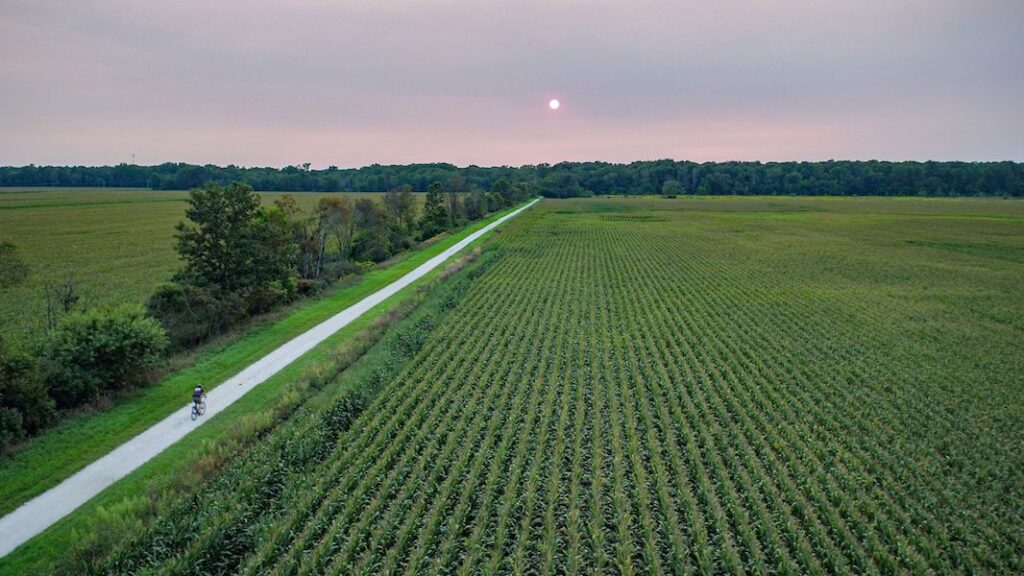
If the Kal-Haven Trail’s historical markers and rustic beauty add context and interest, those qualities also increase the number of trail users and prolong the time they spend there. Green mentions half a dozen cafés and restaurants that have seen a boom in business since the trail was developed, even in winter with the snowmobiler traffic.
“Having these historical panels causes users to engage with the landscape and the communities along the way,” said Green. “They slow down to read the signs, they spend more time on the trail, and they end up visiting restaurants and other businesses along the way.”
The Kal-Haven also benefits from being connected to two additional southwest Michigan rail-trails: the Kalamazoo River Valley Trail, which connects to the Kal-Haven’s eastern terminus, and the Van Buren Trail State Park, with a trailhead about 2 miles from its western trailhead via paved streets. Beginning in 2019, the Kal-Haven Trail was also designated part of the larger cross-state Great Lake-to-Lake Trail #1, which leads from South Haven to Port Huron.
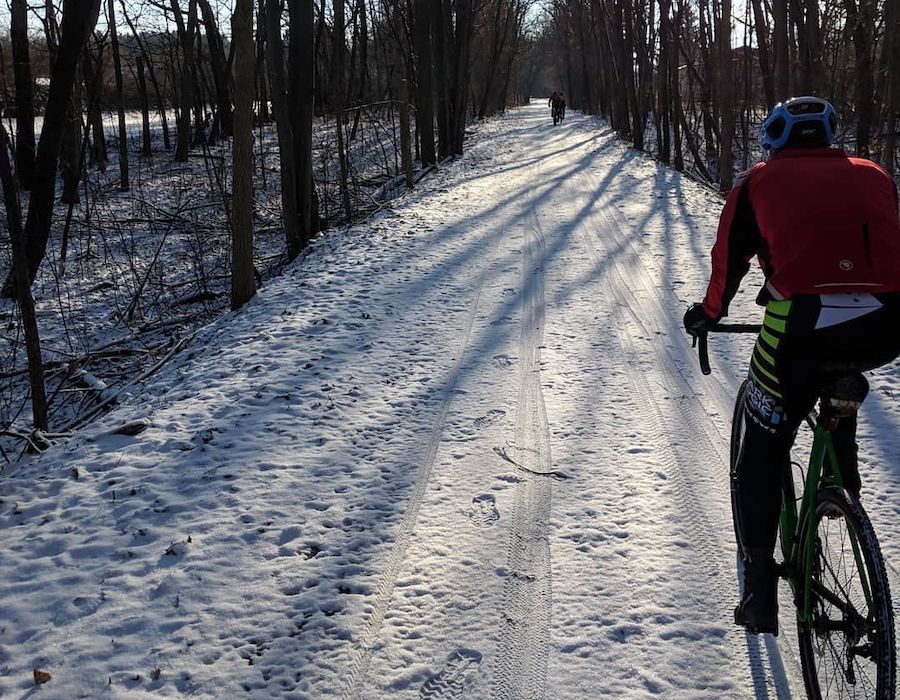
“The idea [behind linking individual trails] was to create destination trails, trails that would attract large numbers of people,” said Andrea LaFontaine, executive director of both the Michigan Trails and Greenways Alliance and the Great Lake-to-Lake Trails Alliance. “Drawing more people to an area naturally draws more money to a destination.”
Green enthused that people have traveled from hundreds of miles away to visit the region. “Last summer people came from Dayton, Columbus and Cincinnati, from Omaha and Indianapolis and points in between, just to ride the Kal-Haven Trail.” And that’s to say nothing of the kids he sees utilizing the trail near his home in Grand Junction to bicycle to school.
“It’s not nationally famous like the Katy Trail,” said Green, “but we’ll get there.”
RELATED: Michigan Trail System Makes Connections From Lake to Shining Lake
Rail-Trails: Michigan & Wisconsin Guidebook
Want to experience this trail or some of the other great trail destinations in Michigan and Wisconsin? You’ll find maps, helpful details and beautiful photos of 63 multiuse trails across the region in our “Rail-Trails: Michigan & Wisconsin Guidebook,” available in our online Trail Shop.
Related Links
- Michigan Department of Natural Resources
- Friends of the Kal-Haven Trail
- South Haven/Van Buren County Convention & Visitors Bureau
- Discover Kalamazoo
Trail Facts
Name: Kal-Haven Trail State Park
Used railroad corridor: Kalamazoo & South Haven Railroad
Trail website: Michigan Department of Natural Resources
Length: 34 miles
County: Kalamazoo, Van Buren
Start point/end point: Kal-Haven Western Trailhead at 33 N. Bailey Ave. (South Haven) to the Kal-Haven Eastern Trailhead at 4143 N. Tenth St. (Kalamazoo)
Surface type: Primarily hard-packed crushed limestone with brief paved portions near South Haven, Bloomingdale and Kalamazoo.
Grade: The general grade of the Kal-Haven Trail is less than 2%.
Uses: Walking, bicycling and cross-country skiing, plus snowmobiling after Dec. 1 and when at least 4 inches of snow are present. The trail is also wheelchair accessible.
Difficulty: The Kal-Haven Trail ranks as an easy trail with a very mild climb up glacial moraine near the Kalamazoo trailhead on the route’s eastern end.
Getting there: The Gerald R. Ford International Airport (5500 44th St. SE, Grand Rapids) is approximately 65 miles from South Haven and 50 miles from Kalamazoo. The Kalamazoo/Battle Creek International Airport (5235 Portage Road, Portage) is approximately 45 miles from South Haven and 10 miles from the Kalamazoo trailhead. Amtrak serves travelers arriving in Kalamazoo (459 N. Burdick St.).
Access and parking: Parking is available at the following trailheads and street intersections, listed from west to east along the trail:
- South Haven: Kal-Haven Western Trailhead at 33 N. Bailey Ave.
- Lacota: Baseline Road and County Road 687
- Grand Junction: Phoenix Street and County Road 215
- Bloomingdale: Kalamazoo Street and Van Buren Street
- Gobles: M-40 and Depot Street
- Kalamazoo: Kal-Haven Eastern Trailhead at 4143 N. Tenth St.
To navigate the area with an interactive GIS map, and to see more photos, user reviews and ratings, plus loads of other trip-planning information, visit TrailLink.com, RTC’s free trail-finder website.
Rentals: Rent a bike in South Haven, approximately 1 mile southwest of the Kal-Haven Western Trailhead, from Rock ‘n’ Road Cycle (315 Broadway St.; phone: 269.639.0003). In Kalamazoo, you can rent from Kzoo Swift (1305 S. Westnedge Ave.; phone: 269.351.2453), which is approximately 7 miles from the trail’s eastern terminus.

Donate
Everyone deserves access to safe ways to walk, bike, and be active outdoors.



